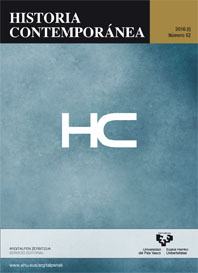Story of a monument never built The Infante Dom Henrique's monuments and the Estado Novo self-representation
##plugins.themes.bootstrap3.article.main##
##plugins.themes.bootstrap3.article.sidebar##
Abstract
The story of Infante D. Henrique's monument is a story about a monument that never was build; however, counting that the planning phase lasted more than twenty years, it's possible to see the monument as an important case studies to study the Estado Novo self-representation and propaganda from 1933 until 1957. The idea to erect a monument dedicated to the most important personality of Descobridores, arose at the end of nineteenth-century, but it gained a strong importance during the Estado Novo, thanks to the special attention paid by the regime for patriotic virtues pedagogy and the glorification of the Edad de Oro. For these reasons a study about the three contests proclaimed to build the Sagres's monument (1933-35; 1936-38; 1954-57) allows to investigate some cultural political topics of Estado Novo.
The public use of history —thanks to the constant use of some myths and symbols— in the Portuguese national identity process, in particular, the connection between the saudade for the Descobridores' era and the «new future» characterized by a national rebirth; the link between art, arquitecture and politics in a delicate period in which the fascist propaganda used during Thirties ended, and a new cultural politics appeared after the WW2.
##plugins.themes.bootstrap3.article.details##
Estado Novo, Modernism, monument, cultural politics, public use of history, national identity
Authors publishing in the journal Historia Contemporánea agree to the following terms:
- Authors retain full copyright of their papers, but also grant copyright to the academic publisher (UPV/EHU Press) for the purposes of copyright management, vigilance and protection.
- Papers are by default published with a non-restrictive Creative Commons CC-BY-NC-ND 4.0. You are free to: Share, copy and redistribute the material in any medium or format. The licensor cannot revoke these freedoms as long as you follow the license terms. Under the following terms:
Attribution — You must give appropriate credit, provide a link to the license, and indicate if changes were made. You may do so in any reasonable manner, but not in any way that suggests the licensor endorses you or your use.
NonCommercial — You may not use the material for commercial purposes.
NoDerivatives — If you remix, transform, or build upon the material, you may not distribute the modified material.
No additional restrictions — You may not apply legal terms or technological measures that legally restrict others from doing anything the license permits.
- If an author requires a more restricted CC license (e.g. CC-BY-SA), this can be provided by contacting our publisher at: publications@ehu.eus
- In particular, and without having to request additional permission, CC BY-NC-ND licensed papers can be deposited in institutional repositories and academic web sites.
- Postprints (i.e. accepted but non-edited versions of the manuscript) can also be pre-published online, providing acknowledgement of authorship and source is specified as above.
For non-standard uses of papers or materials published in Historia Contemporánea, please contact our publisher UPV/EHU Press at: publications@ehu.eus

